Padel is a sport that is full of little rules that can confuse newcomers to the game. This is especially true if the newcomer to padel has never watched other racket sports such as tennis or squash before.
Some people like to learn the rules of a new sport just by watching, but I also know there are some people who prefer to read about the rules either before or while they watch! This is my preferred method, and it’s also the reason I chose to write this post!
If you’re new to the sport and wanting a comprehensive, easy to understand breakdown of the padel serve rules, then you’re in the right place. Alternatively, you may have watched padel for quite a while and you’re just wanting to refresh your memory. This post will be great for you too! We’ll first cover the rules of hitting a serve, and then we’ll go over the rules that the team returning the serve must adhere to. If that sounds good to you – let’s begin!
Rules For Serving In Padel
In a padel match, all points begin with the service. If the first serve is a fault, the serving player will have an opportunity to hit a second serve. If that serve is also a fault, then the returning team will be awarded a point.
At this point you’ll probably be wondering what it takes for a serve to be declared a fault! This is a key question that you’ll need to know the answer to if you want to hit valid serves and avoid giving your opponents free points. There are 10 different ways to hit faults in padel, so if you want to avoid all of them, make sure you stick to the following rules:
- The serving player must remain completely behind the service line and must not cross the centre line of the court until the ball has been served
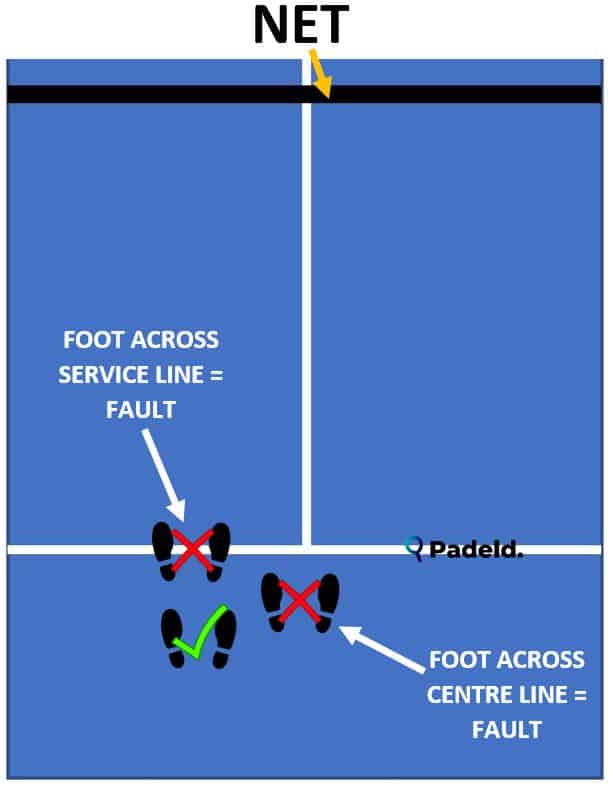
- The serving player must keep at least one foot on the ground throughout the serve motion
- The serving player must bounce the ball behind the service line before striking it
- The serving player must only hit the ball when it is at or below waist height
- The serve must be hit into the receiving box that is diagonally opposite the serving player
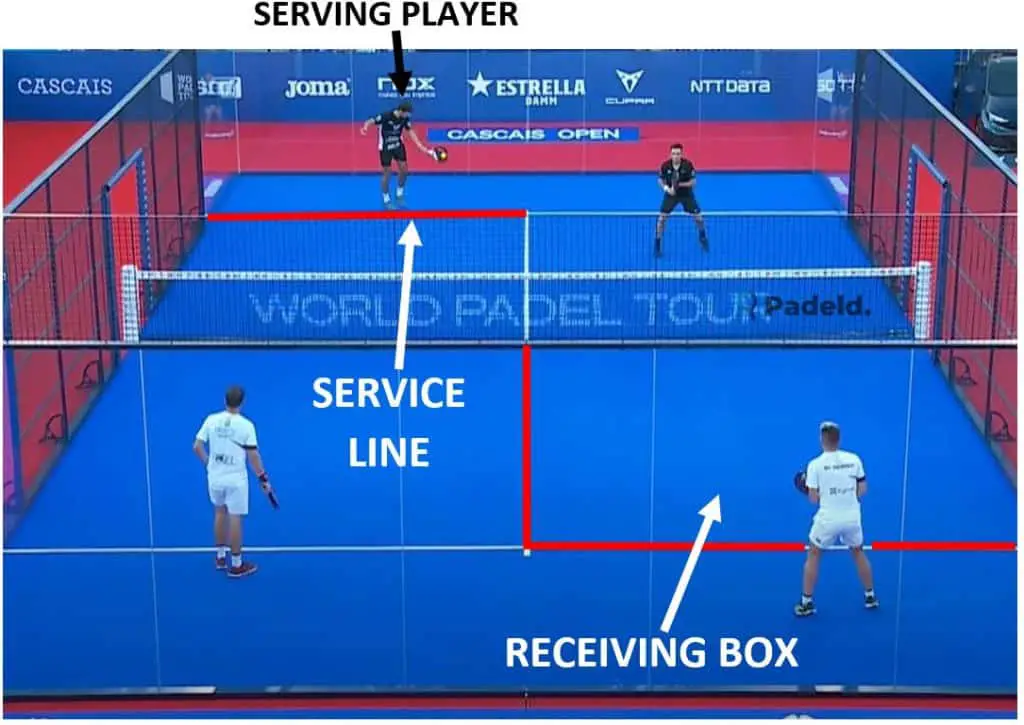
- The serving player must not walk forward, run or jump as they hit the serve
- The serving player must hit the ball when they attempt to serve
- The serve must not cause the ball to touch the metallic fence that surrounds the court before the ball has bounced on the ground for a second time
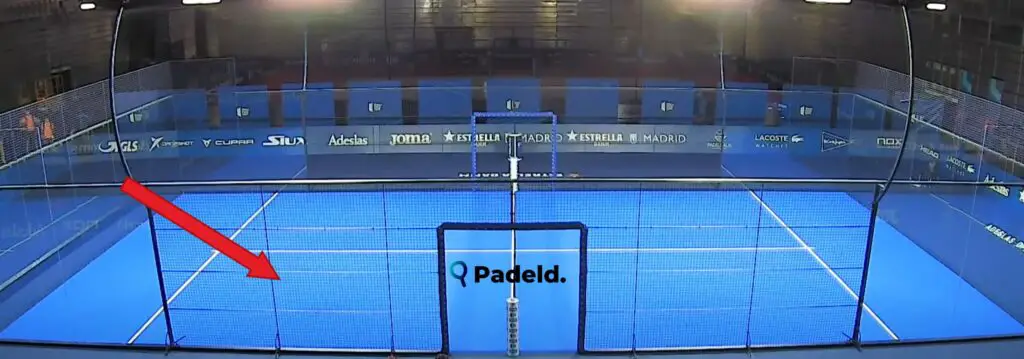
- After the ball has been served it must not hit the serving player, their partner or any object/item of clothing worn by either of the serving duo before it hits the ground on the opponent’s side of the court
- If out of court play is not allowed, the serve must not cause the ball to bounce out of the court through the gates in the side wall
If you stick to the rules above, you won’t go far wrong in a padel match! We’ll now go through a few more questions about the serve to give you a greater understanding of how it works!
Who Serves First In A Game Of Padel?
The choice of which pair of players will service first is decided by the coin toss at the start of a match. Before play begins, the umpire will flip a coin and ask one player to call out heads or tails. Whoever wins the coin toss will be able to choose whether they will be serving or receiving in the first game of the match.
As for which individual player serves first, this is a decision that is made by each pair of players. So, if your team wins the coin toss at the start of a game, you can decide between you and your partner who is going to be the player that hits the first serve.
How Does The Service Alternate Throughout The Match?
At the start of each set, each pair will choose which of their players will serve first, as I explained in the section above. The other player will then serve in their second service game.
As an example, let’s say a padel duo such as Lebron and Galan has chosen to serve first in the first set of a match. The pair decide that Lebron will serve the first game. Once this is complete, the other team will serve for one game, with Lebron and Galan receiving. When the opponent’s service game is done, it would be Galan’s turn to serve in the third game of the set. Lebron would then serve the 5th game of the set, and this order would continue until the set was complete.
Once the order of service has been established it cannot be changed until the beginning of the next set, where the duo could decide to serve with Galan first if they wished to.
What Is A ‘Let’ During A Padel Serve?
If the umpire declares a ‘let’ after the ball has been served, this basically means that the serve will have to be repeated.
So when will the umpire decide that a serve is a let? The umpire will declare a serve as a ‘let’ if the serve hits the net (or the net post) and the ball then goes on to land in the correct receiving box that is diagonally opposite the serving player. If the ball hits the net and then lands outside the correct receiving box, or hits the metal fence at the side of the court, the serve will be declared a fault – not a let. In some cases, an umpire/referee may also call a serve a let if the serving player hits the ball when their opponent is not ready.
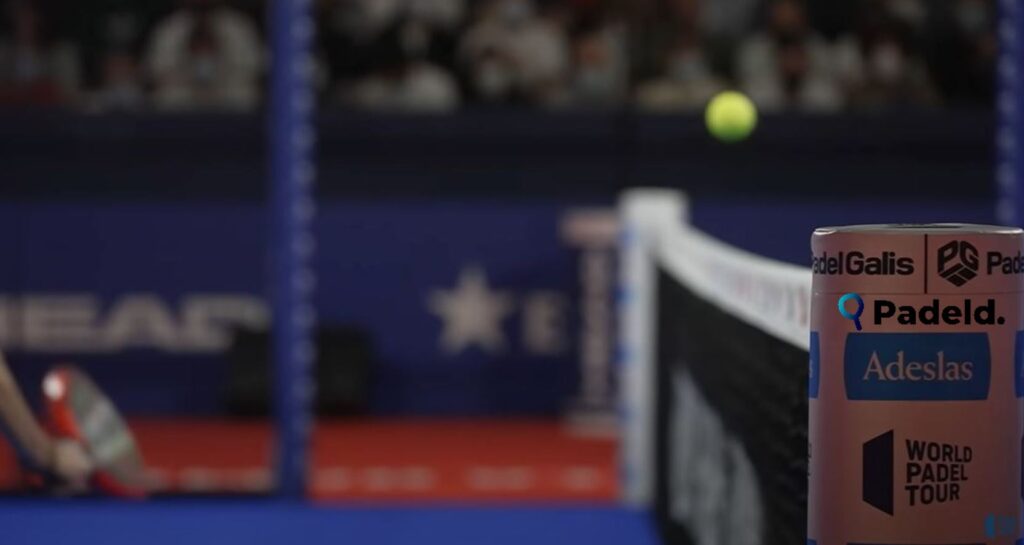
If the let occurs on the first serve, then the serving player will have another attempt at hitting a first serve. If the let occurs on the second serve, then the serving player will be able to have another attempt at a second serve. If a player hits multiple let serves in a row, they will keep receiving more chances to hit a valid serve. There is no limit to the number of lets that can be hit in a row, however it is rare to see more than two hit consecutively!
Can You Hit A Backhand Serve In Padel?
Yes, it is possible for players to hit serves with their backhand as well as their forehand in padel. There are certain reasons why players may wish to use a backhand serve instead of a forehand one, and you can read more about those reasons by reading one of my other posts which is linked here!
Rules For Returning The Serve In Padel
Now you know all of the rules that apply to hitting serves, it’s probably best that I teach you all of the rules that apply to returning serve too! This is another area where padel players (especially inexperienced ones) can make mistakes – so it’s best to try and get a good understanding of these rules as quickly as you can. Let’s go through all of the key ones below…
Can The Receiving Player Volley The Ball?
The receiving player is not allowed to return a serve with a volley in padel. They must allow the ball to bounce in the receiving box before they strike it. If a receiving player does hit the ball before giving it the chance to bounce, the serving duo will be awarded a point!
If you’d like to read a bit more about this – I have a dedicated post on it that you can read by clicking here.
Where Should Receiving Players Stand?
The only real rule that governs where the receiving players should position themselves is the rule that states that the receiving duo must be on the opposite side of the net to the player that is serving the ball. Apart from this, the receiving players are actually allowed to position themselves anywhere on that side of the net.
However, although there is technically no rule setting out where exactly they should stand, most receiving players will choose to stand just behind the service line diagonally opposite the player who is hitting the serve. They will choose to stand in this position because a serve must always be hit into the receiving box that is diagonally opposite the serving player – as we discussed earlier! Therefore, positioning yourself in the area of the court shown in the diagram below gets you in a good starting position to hit your return!
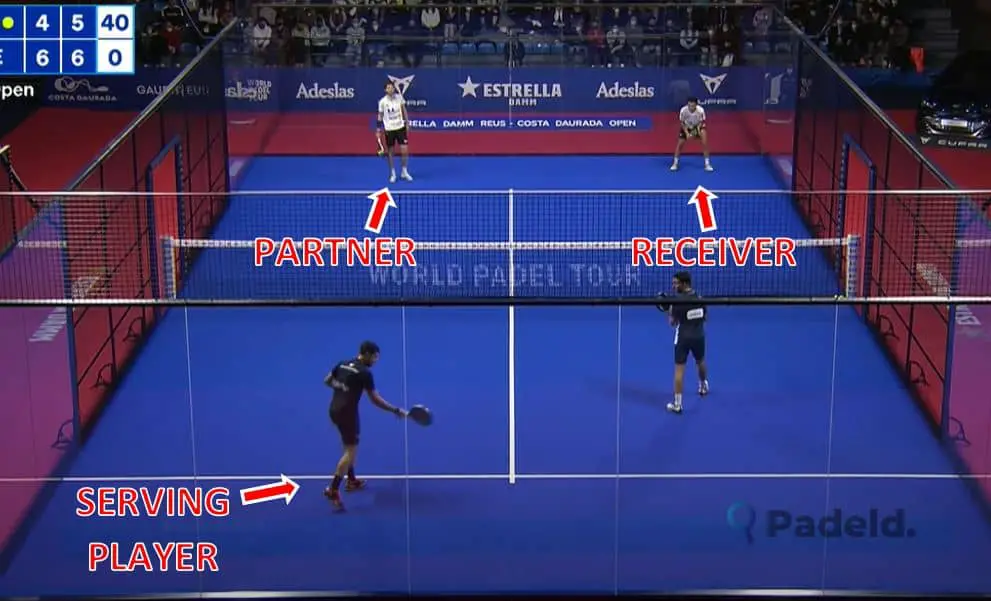
If you look again at the diagram above, you can see that the receiving player’s partner is on the other side of the court. This is a common position as it allows the receiving player to cover one half of the court, and them to cover the other half.
If you’d like to read a more detailed post on the options for where receiving players should stand during a padel point – click here!
Who Receives Serve First In A Padel Match?
We already know how each pair of players decides which one of them serves first, but how does each pair decide who receives the first serve? Thankfully this process is quite simple!
Imagine a padel match is just beginning. It’s the first game of the first set, and Team A is serving first whilst Team B is receiving. All Team B needs to do initially is to choose a player from their team to receive first. Once this has been decided, that player will return serve for the first point of that game, as well as every other return game in the set. Once the first point has been won, the receiving players will swap roles, allowing the other player to return serve instead. The roles of each player will alternate in this way until the end of the set, or until a tie-break begins!
Once a new set or a tie break begins, the receiving team can decide to reverse the order of who returns serve first if they wish to do so.
Conclusion
I hope that this post has answered all of the queries you had about serving or receiving serve in padel! I’ve said this many times on this site, but the serve is an area of a padel match that a lot of players overlook because it looks so simple. However, it’s an area that can benefit your game massively if you cut out mistakes and adopt the correct tactics with a good deal of accuracy. A team that serves well will put the opposition on the back foot and get themselves into strong positions early in the point, from which it is much easier to hit winners or force your opponent into mistakes.
